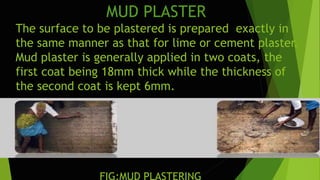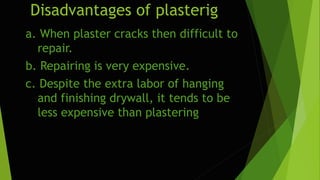Plastering
- 3. COURSE TITLE : DETAILS OF CONSTRUCTION COURSE NO : CE-2110
- 4. PRESENTED TO: MD. MOTIUR RAHMAN ASST. PROFESSOR DEPT. OF CIVIL ENGINEERING
- 5. PRESENTTED BY : GROUP- 07 MD.FARID HASAN (141133) MD. SAJJAD HOSAIN (141134) MST.MEHERUNNESA (141135) MD.RUHUL AMIN (141136) MD.PARVEZ ALI AKANDA (141137)
- 6. PLASTERING
- 7. Plastering Defination of plastering : The word “plaster” comes from the Greek language meaning “to daub on”. This is the process of covering rough surfaces with a plastic material to obtain an even, smooth, regular, clean & durable surfaces. On the other hand we say that; A mixture of lime or gypsum, sand and water, sometimes with fiber added, that harden to a smooth solid and used for coating walls and ceilings.
- 8. Charateristics of good plastering 1. Should be fire and sound. 2. Should provide a smooth, non absorbent and washable surface 3. Should adhere to the surfcesfirmly . 4. Should be weather proof . 5. Should be free from volumetric changes while setting and drying
- 9. Plastering Materials 1.Cement 2.Lime or clay 3.aggregates 4.water 5.Accelator 6.Admixture
- 10. Plastering Materials Mixer of plastering materials
- 12. PLASTERING TOOLS
- 13. PLASTERING TOOLS
- 14. Kinds of plastering : There are several different types of plaster such as: (a) Lime plaster (b) Cement plaster (c) Mud plaster (d) Stucco plaster (e) plaster on lathe
- 15. Lime plaster: When lime is used as the binding materials it is called lime plaster. Lime plaster is a type of plaster composed of hydrated lime , sand and water . lime plaster is similar to lime mortar , the main difference is the based on use rather than composition. Hydralic lime is harder and stronger. Moter for lime plaster is usually prepared by mixing sand and lime in equal properties .Cement is small quantity added to the mixer to improve its strength
- 17. MUD PLASTER The surface to be plastered is prepared exactly in the same manner as that for lime or cement plaster. Mud plaster is generally applied in two coats, the first coat being 18mm thick while the thickness of the second coat is kept 6mm. FIG:MUD PLASTERING
- 18. FIG : MUD PLASTER
- 19. Stucco is the name given to a decorative type of plaster which gives an excellent finish. Stucco plaster can be used for interior as well as exterior surfaces. It is usually laid in three coats making the total thickness of the plaster to about 25mm. the first coat is called the scratch coat ; the second a finer coat , also known as the brown coat , and the third is called white coat or finishing coat. STUCCO PLASTER
- 21. CEMENT PLASTER When cement is used as the binding materials , it is called cement plaster . It isespecially suited for damp condition .cement plaster is usually applied in one coat. The thickness of coat can be 12mm,15mm or 20mm depending upon the site conditions and type of building. When the thickness of plaster is more than 15mm.6mm thickness of cement plaster and cement mortar 1:3 or 1:4 is recommended for cement plastering on RCC surfaces.
- 22. FIG : CEMENT PLASTER
- 23. PLASTER OF LATH Lathing may be either of wood or that of expanded metal. Wooden lathe consists of thin strips of well seasoned wood , about 25mm .in width and 90 to 120cm.
- 24. FIG: PLASTER OF LATH
- 25. Procedure of cement plastering *Average thickness of cement plastering is 12-15mm. *Clean the surface with water and is kept wet till applying plaster. *Preliminary coat is applied on the surface to fill up hollow portion of masonry. *First coat is applied with a thickness of 9-10mm. *Second coat is applied after 6hrs and thickness of second coat is 10mm. *Surface is polished with a trowel. *Third coat if required is applied with maximum thickness 3mm. *Completed plaster is allowed to rest for 24hrs and well watered for at least one week. *Slow setting under higher humidity improves the strength of plaster
- 28. Cracking a. Old surface not being properly prepared. b. Movement in the backing either on account due to shrinkage caused by the drying of the backing material. c. Excessive shrinkage of plaster due to the application of mortar in thick coats.
- 29. Efflorecence FIG:Efflorecence It is solvable salt are present in bricks or the mortar they absorb moisture. From atmosphere and go in to solution which appears on the surface in the form of whitish substance as the moisture dries out and the salts crystallize. Remove of efflorescence by applying a solution zinc sulphet and water and brushing off the surface when dry.
- 30. Filling out of plaster Filling out plaster a. The adhesion of the plaster to the back ground may not be perfect. b. The suction of the backing materials may not be uniform. c. Excessive thermal changes in plaster.
- 31. Blowing of plaster This consists of information of small patches of plaster swelling out beyond the plastered surface and chiefly due to improper slaking of lime particles in the plaster.
- 32. Advantages of plastering a. Easy in application. b. No surgery is required. C. Plaster is the most common form of interior wall finishing. d. If properly mixed and applied , a plaster coating creates a stronger and more durable. e.Provides facilities for cleaning . Increase durability to the work of the foundation. f. Protect the basic work of the climate action.
- 33. Disadvantages of plasterig a. When plaster cracks then difficult to repair. b. Repairing is very expensive. c. Despite the extra labor of hanging and finishing drywall, it tends to be less expensive than plastering
- 34. Conclution *Some main properties of plaster that was highlighted by consumers and the durability , workability , thickness, and setting time. *Also , the tools and materials used in plastering process was listed. * In addition, the method to do plastering was explained. * Finally, the problem for common plastering process and their suggested solution.
- 35. THANKS TO ALL
- 36. THE END



































